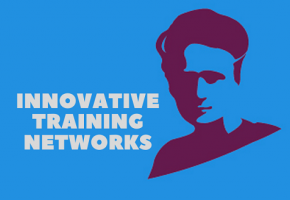
Marie Skłodowska-Curie Actions (MSCA)

RISE

IF

ITN
Proof of Concept for a platform for fast and general elucidation of the interaction between Proteins and RNA
- Principal Investigator - Mgr. PharmDr. Peter Josef Lukavsky, Dr. rer. nat.
- Acronym: ProteRNA
- Project partners: KELADA PHARMACHEM; ARISTOTLE UNIVERSITY OF THESSALONIKI
- Project type: H2020-MSCA-RISE-2020
- Project duration: 1. 7. 2021 – 30. 6. 2024
- Total budget: 257 600 EUR
- Project website: TBD
Project description: The aim of this project is to bring together subject matter experts from the academic and non-academic sectors to develop and establish proof-of-concept of the utility of a new platform for fast and general elucidation of the interaction between proteins and RNA. The development of analytical methods for identification of RNA-binding proteins (RPBs) and their corresponding RNA motifs, will facilitate:
i) a deeper understanding of the roles of gene regulation and protein expression;
ii) accelerate development of personalised medicines via regulation of protein expression; and
iii) enable rapid identification of proteomes involved in specific diseases.
In doing so, this project will have outputs which in the medium term will have significant market opportunities and societal benefits, including, but not limited to, stimulating job creation in the pharmabiotech and diagnostics sectors and in the longer term reducing costs for national and EU healthcare budgets.
 Mgr. Bc. Michaela MusilováProject Manager
Mgr. Bc. Michaela MusilováProject Manager| Phone: | +420 54949 7320 | |
|---|---|---|
| Email: | michaela.musilova@ceitec.muni.cz | |
| Workplace: | Kamenice 753/5, Brno, 625 00, office E35/134 |
Integrative structural biology of pathological tau protein, an appealing therapeutic target for Alzheimer’s disease modifying drugs
- Principal Investigator: RNDr. Mgr. Jozef Hritz, Ph.D.
- Acronym: InterTAU
- Project partners: Latvian Institute of Organic Synthesis; Axon Neuroscience; Royal College of Surgeons in Ireland; Oregon State University; University Health Network; University of Pittsburgh; National University of Cuyo
- Project type: H2020-MSCA-RISE-2019
- Project duration: 1. 1. 2020 – 31. 12. 2023
- Total budget: 1 058 000 EUR
- Project website: www.intertau.eu
Project description: Integrative structural biology of pathological tau protein, an appealing therapeutic target for Alzheimer's disease modifying drugs
- is establishing a strong network of academic-industrial partners with cutting-edge, unique proprietary technologies and knowledge
- is achieving scientific advancement in understanding the pathways of tau in neurodegeneration
- is adopting a unique panel of techniques and considering important interaction partners of pathologic tau
- is fostering novel tools for neurodegeneration diagnostics and therapy
 Ing. et Ing. Mariana Tesařová, MSc Project Manager
Ing. et Ing. Mariana Tesařová, MSc Project Manager| Phone: | +420 54949 8175 |
|---|---|
| Email: | mariana.tesarova@ceitec.muni.cz |
| Workplace: |
 Ing. et Ing. Markéta HonzováProject Administrator
Ing. et Ing. Markéta HonzováProject Administrator| Phone: | +420 54949 4168 |
|---|---|
| Email: | marketa.honzova@ceitec.muni.cz |
| Workplace: |
Novel Network-Based Approaches for Studying Cognitive Dysfunction in Behavioral Neurology
- Principal Investigator - prof. MUDr. Irena Rektorová, Ph.D.
- Acronym: CoBeN
- Project partners: University of Arizona; University of Szeged
- Project type: H2020-MSCA-RISE-2016
- Project duration: 1. 3. 2017 – 28. 2. 2021
- Total budget: 306 000 EUR
- Project website: http://coben.ceitec.cz/
Project description: The project will employ novel behavioral paradigms and state-of-the-art imaging techniques to:
- identify neural underpinnings of language, speech and cognitive impairment in different patient groups (stroke, Parkinson’s disease, dementia) across three languages (Czech, English, Hungarian),
- unravel the therapeutic potential of NIBS (non-invasive brain stimulation) by targeting and modulating distinct brain networks in these patients
The international collaboration between partners builds on the complementary expertise of researchers, promotes the transfer of knowledge, provides infrastructure to develop the careers of the staff members, and develops a new model for training future generations of behavioral neurologists.

 Mgr. Bc. Michaela MusilováProject Manager
Mgr. Bc. Michaela MusilováProject Manager
| Phone: | +420 54949 7320 |
|---|---|
| Email: | michaela.musilova@ceitec.muni.cz |
| Workplace: |
 Ing. et Ing. Markéta HonzováProject Administrator
Ing. et Ing. Markéta HonzováProject Administrator
| Phone: | +420 54949 4168 |
|---|---|
| Email: | marketa.honzova@ceitec.muni.cz |
| Workplace: |
Excellence in research and development of non-coding RNA DIAGnostics in ONcology

- Principal Investigator: prof. RNDr. Ondřej Slabý, Ph.D.
- Acronym: RNADiagon
- Project partners: MD Anderson Cancer Center; Medical University of Graz; Research Center for Functional Genomic; The Institute of Tumour Biology; The University of Ferrara; BioVendor Group
- Project call: H2020 Excellence Science - MSCA-RISE
- Project duration: 1. 2. 2019 - 31. 1. 2023
- Total budget: 662 400 EUR
- Project website: http://www.rnadiagon.eu/
Project description: RNADIAGON is an academic-industrial consortium focused on research and development it the field of non-coding RNA diagnostics in oncology. This consortium enables development of personal skills and knowledge of early-stage and experienced researchers from 5 European academic centers through their (i) long-term stays at the US research center of excellence (MD Anderson Cancer Center, University of Texas, USA) and (ii) traineeships at the education center and manufacturing facilities of industrial partner (BioVendor, Inc.) developing certified (CE-IVD) diagnostics, who will work on the development of a new non-coding RNA diagnostic kit in colorectal cancer adopted here as a model project.
 Mgr. Ivana Chalupová Project Manager
Mgr. Ivana Chalupová Project Manager| Phone: | +420 54949 8762 |
|---|---|
| Email: | ivana.chalupova@ceitec.muni.cz |
| Workplace: |
 Ing. et Ing. Markéta HonzováProject Administrator
Ing. et Ing. Markéta HonzováProject Administrator| Phone: | +420 54949 4168 |
|---|---|
| Email: | marketa.honzova@ceitec.muni.cz |
| Workplace: |
Deciphering the Language of DNA to Identify Regulatory Elements and Classify Transcripts Into Functional Classes
- Principal Investigator: Petr Šimeček, Ph.D.
- Acronym: LanguageOfDNA
- Project type: H2020 Excellence Science - MSCA-IF-2019
- Implementation period: 01.06.2020 - 31.05.2022
- Budget: 156 980.64 EUR
Project description: The genomics era dawned about two decades ago with the completion of a multi-billion project sequencing the complete human genome. Today a similar task is within reach of any modestly equipped lab, due to the advances in sequencing techniques. Thousands of new species are now having their genome sequenced per year. A volume of produced genomic data challenges the interpretation capacity of classical statistical methods, opening the doors for novel machine learning approaches.
A genomic sequence can be conceptually seen as a close parallel to a human language. Both utilize information (nucleotides/codons and phonemes/syllables) to encode and transmit a signal that can be faithfully decoded, with attention to error minimization, at the receiving end. Genomic messages are a product of multiple and often contradictory evolutionary pressures and are aimed to be decoded at the same time by many different actors in variable ways. For example, a genomic sequence could encode for a protein product, thus displaying a three-nucleotide / codon-based language model. However, it has also subtexts of the regulation (a codon sequence can include motifs aimed at RNA binding proteins), structural information (functional RNA folding patterns pressuring sequences to a specific direction) and so on.
The main challenge of applying machine learning models to the identification of genomic function is to find creative ways to untangle these multiple layers of subtexts and focus on each type of message separately. We will adapt algorithms recently developed for the processing of human languages and use them for the classification of RNA transcripts into functional classes and the classification of untranslated functional genomic regions (enhancers, transcription factor binding sites). We will create ready-to-use datasets to benchmark existing and future methods in this field and make all DNA/RNA language models publicly available.
Investigating the transcriptional regulation of auxin biosynthesis in Arabidopsis embryo
- Principal Investigator: Subodh Verma, Ph.D.
- Acronym: ITRABAE
- Project type: H2020 Excellence Science - MSCA-IF-2019
- Implementation period: 01.01.2021 - 31.12.2022
- Budget: 144 980.64 EUR
Project description: Survival of flowering plants is determined by the proper production of seed, whose shape and size are defined by the development of an embryo. Such mature embryo mimics the body pattern of the new plant that will develop after germination. Auxin is a key regulator of various aspects of plant development, including embryo morphogenesis. Cellular auxin gradients, maintained by auxin production along with signalling and transport, are essential for proper embryo development. The embryonic local auxin biosynthesis appears spatiotemporally controlled, necessitating the presence of regulatory networks. Also, it became evident that auxin plays a critical role as an integrator of environmental cues, notably high temperatures, known to impair seed production. Thus, I aim at deciphering the molecular and genetic mechanisms behind the spatiotemporal regulation of auxin biosynthetic genes during embryo development, and how this regulatory network is impacted by heat stress. In the proposed work, I will functionally dissect the contribution of AGL transcription factors, identified in a yeast one-hybrid screen as binding to auxin biosynthetic promoters, to the direct regulation of auxin biosynthetic pathways using multidisciplinary approaches such as genetics, metabolomics, and molecular biology. Further, I will investigate whether high temperatures impact this regulation, notably at epigenetic levels. Overall, the proposed work would serve as an excellent foundation to dissect the mechanisms responsible for local auxin biosynthesis during embryo development, which would pave the way to devise strategies for mitigating the effects of climate warming on seed and plant morphogenesis.
 Ing. et Ing. Mariana Tesařová, MSc Project Manager
Ing. et Ing. Mariana Tesařová, MSc Project Manager| Phone: | +420 54949 8175 |
|---|---|
| Email: | mariana.tesarova@ceitec.muni.cz |
| Workplace: |
Protection from malaria in the Fulani ethnic group of West Africa involves reduced levels of A-to-I RNA editing by ADAR1
- Principal Investigator: Jaclyn Elizabeth Quin, Ph.D.
- Acronym: QuinADAR1
- Project type: H2020 Excellence Science - MSCA-IF
- Implementation period: 01.06.2019 - 31.05.2021
- Budget: 144 980.64 EUR
Project description: I will investigate what mediates an effective human immune response to infection with Plasmodium falciparum malaria.
I will approach this through studying the Fulani ethnic group of West Africa, who are relatively resistant to malaria infection. The basis of the Fulani protection from malaria has never been established. However, we have performed a pilot study which suggests that reduced levels of adenosine-to-inosine (A-to-I) editing of RNA by ADAR1 following P. falciparum infection can drive a more effective innate immune response in the Fulani.
We have an established collaboration with the Malaria Research and Training Centre at University of Sciences Technique and Technology in Mali, who have strong ties to the Fulani community. At Stockholm University, I have had the opportunity to develop a strong background in immunology research techniques, specifically utilizing in vitro models of malaria infection in human monocytes, in the research group of Eva Sverremark-Ekström. As the role of RNA modifications is an emerging field, I plan to move to CEITEC, Czech Republic, to work with Mary O’Connell, who has pioneered the role of A-to-I RNA modification in the innate immune response to RNA.
Specifically, we will test the hypothesis that reduced rates of A-to-I editing of RNA in the Fulani following infection enables them to mount a more effective innate immune response to P. falciparum malaria, and contributes to their relative protection from the disease. Further, targeting of ADAR1 and/or reduction in levels of A-to-I RNA levels may present a novel strategy to boost effective immune response to malaria.
Using Deep Learning to understand RNA Binding Protein binding characteristics
- Principal Investigator: Panagiotis Alexiou, PhD
- Acronym: DEEPLEARNRBP
- Project type: H2020 Excellence Science - MSCA-IF
- Implementation period: 01.07.2019 - 09.05.2022
- Budget: 156 980.64 EUR
Project description: New technologies have revolutionized our understanding of RNA binding protein (RBP) function. Global screens for RBPs have pulled down hundreds of proteins for which no discernable RNA Binding Domain is present. These proteins, termed enigmRBPs due to their enigmatic nature, do bind RNA in unknown and variable fashion. An ever increasing number of such RBPs are having their target sites identified via CrossLinking and ImmunoPrecipitation Sequencing techniques (CLIP-Seq). This torrent of data can be harnessed by novel Deep Learning techniques to identify high order characteristics of RBP function.
The aim of this proposal is the development of a machine learning model that can explore the functional implications of RBP binding characteristics. A model that, given an enigmatic RBP, can identify other known RBPs that show similar binding characteristics, such as sequence motifs, conservation motifs, secondary structure motifs, and higher order combinations of the above.
We will focus on methods to practically interpret the machine learning model to biological knowledge, especially higher order filters that can learn the interplay among varied input, such as secondary structure, sequence and conservation. Beyond the theoretical, we will disseminate our methods in easy to use, standalone and web application format, in order to increase the practical application of our research.
We are transplanting expertise from the bioinformatics and machine learning field, into a fertile substrate of RNA biology and CLIP-Seq experimentation. This interdisciplinary project will involve close collaboration and two-way transfer of knowledge in a dynamic research environment.
 Mgr. Bc. Michaela MusilováProject Manager
Mgr. Bc. Michaela MusilováProject Manager| Phone: | +420 54949 7320 |
|---|---|
| Email: | michaela.musilova@ceitec.muni.cz |
| Workplace: |
ROles of ePitranscriptomic in diseasES
- Principal Investigator: Prof. Mary O'Connell, PhD.
- Acronym: ROPES
- Project partners: University of Trento (project coordinator), Medical University of Vienna, University of Lausanne, International Institute of Molecular and Cell Biology, Umea University, Deutsches Krebsforschungszentrum, National Research Council Italy, Centre for Genomic Regulation, Immagina Biotechnology, EPICS Therapeutics Belgium
- Project type: H2020-MSCA-ITN-2020
- Implementation period: 01.12.2020 - 30.11.2024
- Budget: 3 095 829 €
- Web:
Project Description: Epitranscriptomics is the study of RNA modifications and their role in the regulation of gene expression. As happened for DNA, extensive covalent modification of RNA was found already in the 70s. Nevertheless, a spectacular expansion of epitranscriptomics occurred mostly in the past seven years, when an extensive layer of base decorations was discovered in mRNAs and shown to undergo cell modulation. These modifications produce programmable fluctuations in mRNA levels, translatability and subcellular compartmentalization, affecting primary cell programs such as cell differentiation and response to stress. We thus anticipate that RNA modifications will prove as important as chromatin dynamics in shaping cell phenotypes. This emerging field is hence crucial for both basic science and application to human disease. Epitranscriptomic would provide the missing link between genomic variability and cellular phenotypes, contributing to explaining the cause of specific diseases and developing novel therapies. Epitranscriptomic research is dominated by the US and China, with the EU lagging behind. We thus need to rapidly create a European framework to integrate and accelerate research efforts and industrial applications in this emerging field. To address this major European need, ROPES will train a group of Early Stage Researchers who will become the seed of the European epitranscriptome science of this decade. They will join a recently established network of academic research groups and biotech companies devoted to advancing our understanding of RNA modifications while promoting the development of new biomarkers and therapies. Focusing on RNA editing and m6A methylation, ROPES will investigate disease mechanisms and new therapies in the fields of cancer, stem cell diseases and innate immunity, while developing innovative epitranscriptomics methods. The ROPES European Training Network is the first European effort to tackle the epitranscriptome for the advancement of medicine.
 Mgr. Bc. Michaela MusilováProject Manager
Mgr. Bc. Michaela MusilováProject Manager| Phone: | +420 54949 7320 |
|---|---|
| Email: | michaela.musilova@ceitec.muni.cz |
| Workplace: |
LightDyNAmics. DNA as a training platform for photodynamic processes in soft materials
- Principal Investigator: Prof. Jiří Šponer
- Acronym: LightDyNAmics
- Project partners: CONSIGLIO NAZIONALE DELLE RICERCHE (project coordinator); Centre National de la Recherche Scientifique; University of Durham; National Institute of Chemistry; Ludwig-Maximilians-Universität München; Politecnico di Milano; University College Dublin; Università di Bologna; Universität Wien; AstraZeneca Ltd; Baseclick GmbH; Dynamic Biosensors GmbH
- Project type: H2020-MSCA-ITN-2017 (ETN)
- Implementation period: 01.04.2018 - 31.03.2022
- Budget: 3 827 591,28 EUR
- Web: https://www.lightdynamics.eu/
Project Description: The main goal of LightDyNAmics is to achieve a complete understanding of the ultrafast dynamical processes at the molecular scale induced by UV light absorption and DNA, and to einveil the mechanisms leading to photodamage of the genetic code. The project will transfer this knowledge to a broad class of optoelectronic materials, highly relevant for Europe's high-tec industries.
At the same time, LightDyNAmics will train 15 Early Stage Resarchers by crossing the border between theoretical and experimental expertise by performing independent, yet interrelated and complementary research projects focussed on three scientific objectives:
- to develop and optimize a variety of complementary experimental and computational methods for the investigation of ultrafast dynamics in multi-chromophore systems;
- to apply these methods to elucidate photoinduced processes in DNA tracts of different size and complexity, from simple nucleobases in the gas phase to genomic DNA, over different timescales from light absorption all the way to the formation of lesions;
- to generalize the acquired knowledge and transfer it to other multi-chromophore, soft materials of fundamental and technological interest, identifying the photoinduced processes, their spectral signatures, their yields and dynamics.
 Mgr. Ivana Chalupová Project Manager
Mgr. Ivana Chalupová Project Manager| Phone: | +420 54949 8762 |
|---|---|
| Email: | ivana.chalupova@ceitec.muni.cz |
| Workplace: |







